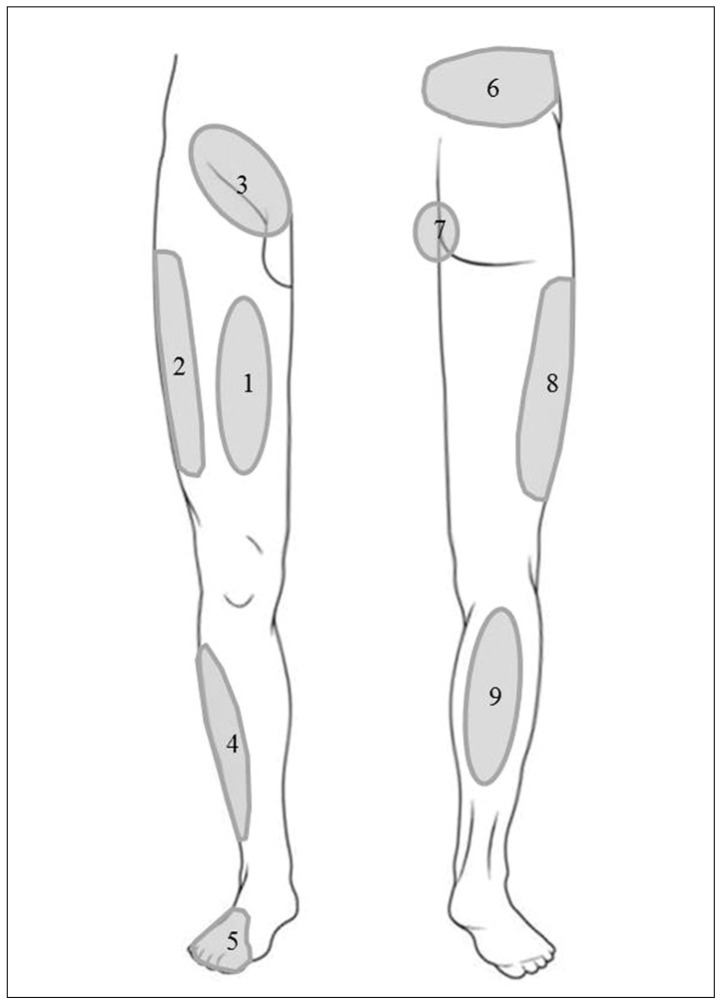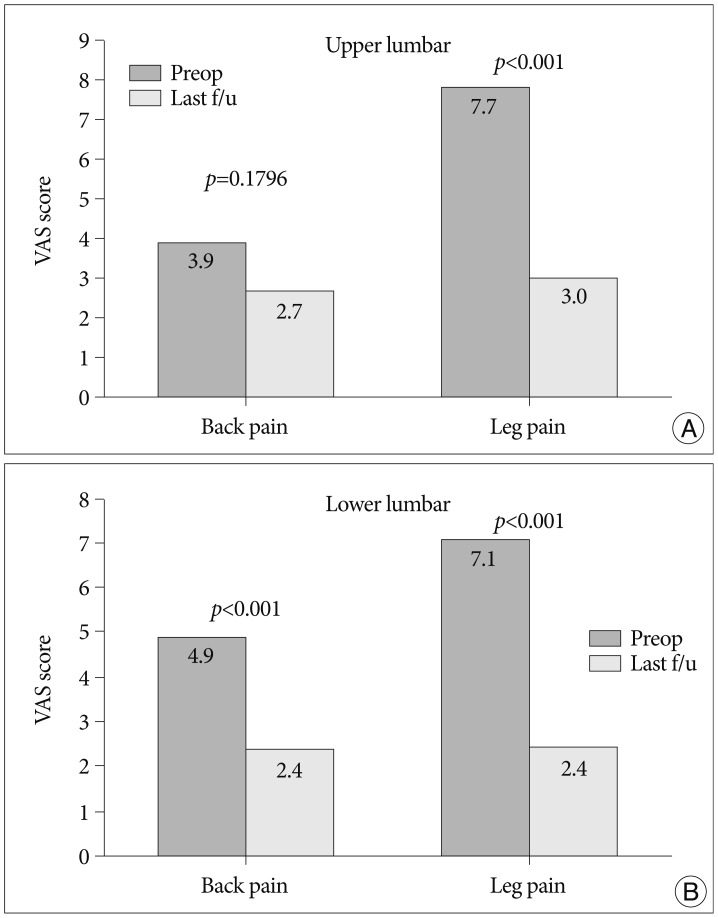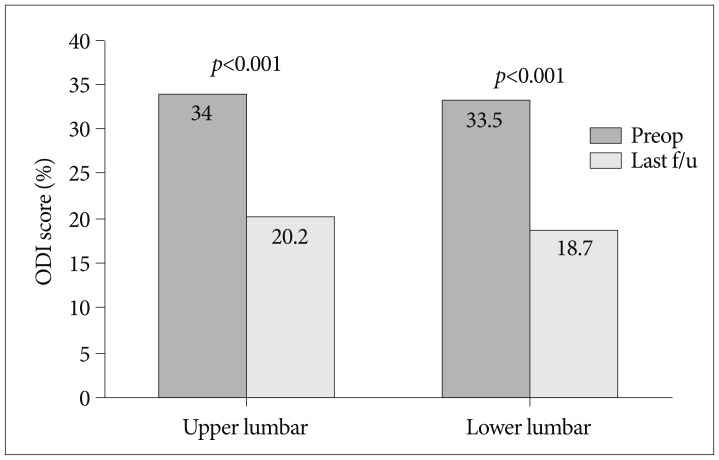J Korean Neurosurg Soc.
2013 Nov;54(5):379-383. 10.3340/jkns.2013.54.5.379.
The Comparative Analysis of Clinical Characteristics and Surgical Results between the Upper and Lower Lumbar Disc Herniations
- Affiliations
-
- 1Department of Neurosurgery, Eulji University College of Medicine, Daejeon, Korea. ks3432@eulji.ac.kr
- KMID: 2138352
- DOI: http://doi.org/10.3340/jkns.2013.54.5.379
Abstract
OBJECTIVE
There are differences in the clinical characteristics and surgical results between upper (L1-2 and L2-3) and lower (L3-4, L4-5, and L5-S1) lumbar disc herniations. We conducted this study to compare the clinical features and surgical outcomes between the two types of lumbar disc herniations.
METHODS
We retrospectively reviewed the clinical features of patients who underwent microdiscectomies from 2008 to 2012. We evaluated the clinical characteristics such as age, preoperative autonomic dysfunction, the presence or absence of previous lumbar surgery and fusion required during surgery. Visual Analogue Scale (VAS) scores about back pain and leg pain were evaluated preoperatively and at the final follow-up.
RESULTS
Upper lumbar group (n=15) was significantly older than lower lumbar group (n=148). The incidence of autonomic dysfunction was significantly higher in upper lumbar group. The number of patients with a previous lumbar surgery was significantly greater in upper lumbar group. There was no statistical significance for fusion required during surgery between two groups. Both groups showed a significant decrease in the VAS scores of leg pain. VAS scores of back pain were significantly decreased in lower lumbar group. But this was not seen in upper lumbar group. Both groups showed significant improvement of Oswestry Disability Index score.
CONCLUSION
Upper lumbar group had different clinical characteristics from those of lower lumbar group and these include older age, a higher incidence of autonomic dysfunctions and a higher incidence of patients with previous lumbar surgery. There were no significant differences in surgical outcomes, except for back pain, between two groups.
Figure
Reference
-
1. Albert TJ, Balderston RA, Heller JG, Herkowitz HN, Garfin SR, Tomany K, et al. Upper lumbar disc herniations. J Spinal Disord. 1993; 6:351–359. PMID: 8219549.
Article2. Bartolomei L, Carbonin C, Cagnin G, Toso V. Unilateral swelling of the lower abdominal wall. Unusual clinical manifestation of an upper lumbar disc herniation. Acta Neurochir (Wien). 1992; 117:78–79. PMID: 1387504.3. Bosacco SJ, Berman AT, Raisis LW, Zamarin RI. High lumbar disk herniations. Case reports. Orthopedics. 1989; 12:275–278. PMID: 2922363.
Article4. Fontanesi G, Tartaglia I, Cavazzuti A, Giancecchi F. Prolapsed intervertebral disc at the upper lumbar level. Diagnostic difficulties. A report on 12 cases. Ital J Orthop Traumatol. 1987; 13:501–507. PMID: 3503877.5. Hsu K, Zucherman J, Shea W, Kaiser J, White A, Schofferman J, et al. High lumbar disc degeneration. Incidence and etiology. Spine (Phila Pa 1976). 1990; 15:679–682. PMID: 2218715.
Article6. Iwasaki M, Akino M, Hida K, Yano S, Aoyama T, Saito H, et al. Clinical and radiographic characteristics of upper lumbar disc herniation : ten-year microsurgical experience. Neurol Med Chir (Tokyo). 2011; 51:423–426. PMID: 21701105.
Article7. Kim DS, Lee JK, Jang JW, Ko BS, Lee JH, Kim SH. Clinical features and treatments of upper lumbar disc herniations. J Korean Neurosurg Soc. 2010; 48:119–124. PMID: 20856659.
Article8. Kortelainen P, Puranen J, Koivisto E, Lähde S. Symptoms and signs of sciatica and their relation to the localization of the lumbar disc herniation. Spine (Phila Pa 1976). 1985; 10:88–92. PMID: 3983706.
Article9. Pásztor E, Szarvas I. Herniation of the upper lumbar discs. Neurosurg Rev. 1981; 4:151–157. PMID: 7301145.
Article10. Saberi H, Isfahani AV. Higher preoperative Oswestry Disability Index is associated with better surgical outcome in upper lumbar disc herniations. Eur Spine J. 2008; 17:117–121. PMID: 17972115.
Article11. Sanderson SP, Houten J, Errico T, Forshaw D, Bauman J, Cooper PR. The unique characteristics of "upper" lumbar disc herniations. Neurosurgery. 2004; 55:385–389. discussion 389. PMID: 15271245.
Article12. Wei CP, Cheng WC, Chang CN, Lee ST, Lui TN, Wang AD. Upper lumbar disc herniation. Changgeng Yi Xue Za Zhi. 1989; 12:193–199. PMID: 2637057.
- Full Text Links
- Actions
-
Cited
- CITED
-
- Close
- Share
- Similar articles
-
- Paramedian Tangential Approach for the Lumbosacral Extraforaminal Disc Herniations
- Surgical Treatment for Upper Lumbar Disc Herniation
- The Comparisons of Surgical Outcomes and Clinical Characteristics between the Far Lateral Lumbar Disc Herniations and the Paramedian Lumbar Disc Herniations
- Clinical Features and Treatments of Upper Lumbar Disc Herniations
- L1-2 Disc Herniations: Clinical Characteristics and Surgical Results




